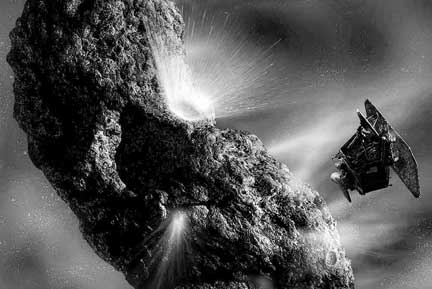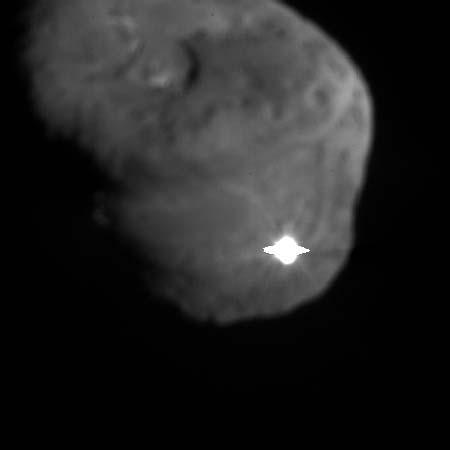Deep Impact's name and its uniqueness was that it carried with it a crash spacecraft (impactor) weighing 370 kg designed to hit it, reveal the internal material, photograph and measure it before, during and after the collision * An unprecedented study in the field of comet research

Comet Temple 1 was discovered on April 3.4.1867, 0.71. Calculations made based on additional observations showed that its orbit around the sun ranges from 1.64-1867 astronomical units. In May 5.68 it was determined that the time it orbits the sun is 5.5 years and its orbit is between Mars and Jupiter. This orbit underwent several geometrical changes during the observations towards it and until today it is now 14.4 years. Based on the set of observations, it was determined that its size is 4.4 - 41 km, it rotates around itself once every 0.3 hours and its density is between 0.9-XNUMX.
This is the fourth comet reached by a spacecraft, Deep Impact, and its uniqueness was that it carried with it a crash spacecraft (impactor) weighing 370 kg designed to hit it, reveal the internal material, photograph and measure it. The measurements were made before, during and after the collision. This is a very dense set of measurements made from the mother spacecraft, the crash spacecraft, terrestrial telescopes and telescopes placed around the Earth. This is actually an unprecedented study in the field of comet research.
Comet Temple 1 was chosen for this purpose due to the relative stability of the orbit. This route allows the sun's radiation to gently "bake" the surface. This "baking" ages and turns them into a protective layer for the material underneath. It was estimated that as a result of the impact a crater with a diameter of hundreds of meters would be created.
The spacecraft was launched on January 12.1.2005, 4.7, arrived at the comet at the beginning of July and hit it on July 500. The release of the crash spacecraft was made at a distance of 14 km from it, a distance close enough to photograph and measure it but far enough so as not to be harmed by the splash that was thrown into space at the time of impact. The minimum distance between the mother spacecraft and the comet occurred 10 minutes - XNUMX seconds after the impact. At this point in time the spacecraft rotated around an axis and was put into orbit around the sun while waiting for a future mission.
The resulting photographs are very sharp. Those transmitted from the mother spacecraft were taken from a distance of 30 km from the surface and the last photographs transmitted from the crash spacecraft were taken 4 seconds before the impact. These are photos with a resolution of 4 meters per pixel and many details can be seen. Analysis of the photographs shows that a crater with a diameter of 120 meters was created and that a large cloud containing dust, ice and rock fragments was blown into space.
During the observations leading up to the impact, 3 jet bursts were observed from the face of the comet, on 14.6/22.6, 2.7/22.6 and 6/14.6. It turned out that the jet from 2 was XNUMX times stronger than the one observed on XNUMX. The amount of water vapor was XNUMX times greater and that of other gases including carbon dioxide was greater. It was estimated that the heating of the comet by the sun caused these eruptions. Two explanations were given for these jets. One explanation is that dust and gas trapped below the surface are released through cracks that form during the approach to the sun and create this jet. The second explanation is that part of the comet's crust is heated and lifted as a result of the pressure of the heated gases below the surface, becomes porous and disintegrates into dust particles a short time later in the shape of a fan. Whether the first explanation is correct or the second, this phenomenon cannot continue for long. .
The photographs that reached Earth showed that the comet was smaller than they thought. Its dimensions are 7 x 2 km and its shape is like a potato. On the surface you can see craters, ridges and probably also glaciers. In its topography it differs from other comets imaged by spacecraft. The craters on its surface are impact craters of various sizes similar to impact craters observed on other bodies in the solar system. Other areas of its surface are smooth. Yes, it is possible to distinguish on its surface a depression that is at least half a kilometer long. This socket was previously covered with a crust that disappeared for unknown reasons. The surface is as black as charcoal or blacker. It appears that the rotation axis points in the general direction that the Earth's rotation axis points. .
Following the impact, a very large cloud of powdery material was blown up. It turned out that the comet was covered with a particularly powdery material. It looks more like talcum powder than beach sand. In photographs taken from the Earth after the impact, they noticed the release of hydroxyls, a direct product of the decomposition of water. In addition to this, large amounts of silica were observed, including organic molecules that were brought to Earth by comets in its early days. The Spitzer Space Telescope found carbonates found in marine shells and clays, which raised many doubts because they can form in liquid water and not on frozen comets. Materials were found that were not distinguished in other comets such as Brazilian compounds and hydrocarbons. The silicates found by this telescope are crystalline grains, smaller than grains of sand. One of the minerals found here is olivine. Other observations found ethane, water and organic compounds. The amount of ethane in the dust is greater than that measured before the impact. Two explanations were given for this. One explanation is that the surface is different from the interior of the comet as a result of heating by the Sun. According to the second explanation, the interior of the comet is a mixture of regions with different compositions, since the nucleus of the comet is a compound of "species of comets", each with its own chemistry. The comet's ethane level is similar to that of the next dominant group of comets from the Kuiper Belt. The day mapping of the comet made it possible to check its internal heat conductivity. In these observations, water evaporation was noticed as a result of the heat of the collision. A few seconds after the collision, ice particles that were below the surface were thrown into space. These particles did not melt or evaporate. The infrared profile of the comet is similar to that of Halley's Comet.
This comet and other comets that have been closely observed by spacecraft open up a new and fascinating field in the study of the solar system. Close observation and from an almost zero distance of the behavior of rock masses, whether they are comets, asteroids or tiny moons orbiting the planets, can give an opening to new insights as to their origin and the solar system as a whole.
Deep Impact First picture of the moment of impact
24.7.2005
On 20/7, NASA released an image of the first moment after the impactor hit Comet Temple-1 on July 4. The illuminated area contains the fragments and fragments ejected from the crater.
The jagged boundaries at the bottom of the flash were created by light created by the collision and causing those pixels in the spacecraft's camera to become saturated. This is as a result of excess electronic charge reaching adjacent pixels in the same column.
By the way, in the meantime comet Temple-1 has returned to its previous level of brightness.

